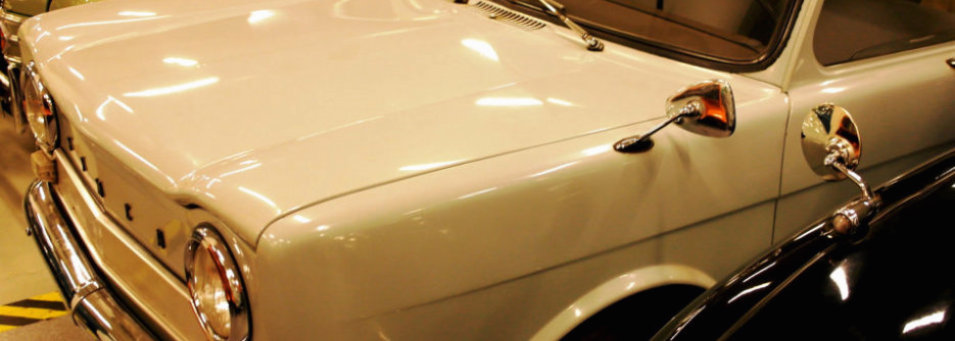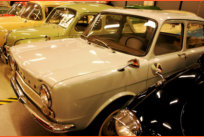



Simca MIlle - in French

Simca 1000 - 66
The Simca 1000 was a small, rear-engined, four-door
saloon manufactured by the French automaker Simca
from 1961 to 1978.
Origins
The origins of the Simca 1000 lie not on France but in Italy. Simca’s President-director general, Henri Pigozzi, had been born in Turin and had known Fiat’s founder, Giovanni Agnelli from 1922 till Agnelli’s death in 1945: the Agnellis still controlled Fiat. Fiat would remain Simca’s dominant share holder till 1963. Pigozzi remained a regular visitor to Fiat’s vast Turin operation throughout his time at the head of Simca, and when Pigozzi visited it was as an honoured friend. Following the launch in 1955 of the well received Fiat 600, Fiat’s development department, still headed up by the legendary designer-engineer Dante Giacosa, set about planning for its successor. The replacement foreseen would be a little larger and more powerful than the current car, reflecting growing prosperity in Italy at the time. Two projects were run in parallel: “Project 119” was for a two door successor, building on the strengths of the current model, while “Project 122” was for a more radically differentiated four door successor. The entrance to the inner sanctum of Fiat’s Development Department would have been blocked to most visitors, but Pigozzi’s privileged relationship with the Agnellis opened even these doors, and during the late 1950s he took a particular interest in the Department. It became clear that Pigozzi’s intentions to extend the Simca range further down in the small car sector aligned closely with Fiat’s own “Projects 119” and “122”, intended to build a presence upmarket from the Fiat 600. Pigozzi obtained the agreement of the Fiat directors to select one of the six different rather boxy four-door clay models and mock-ups that then comprised the output of “Project 122” to be developed into Simca’s new small car. The styling department at Simca was headed up by Mario Revello de Beaumont, another Italian expatriate who had transferred from General Motors in 1955 but who had been born in Rome back in 1907. Dividing his time between Fiat’s Industrial Design Centre at Turin and Simca’s Styling Centre at Poissy, Revello de Beaumont spent the two years between 1959 and 1961 working with Fiat’s Felice Mario Boano, developing the Simca 1000 to production readiness. Although the surviving prototypes differ in detail, the basic architecture and boxy shape of the car had evidently been “right first time” and the Simca 1000 of 1961 is entirely recognizable as the model that Pigozzi had selected from Fiat’s “Project 122”. In the meantime, in Italy the Fiat 600 continued to sell strongly and there was little sense of urgency about investing to replace it. Management evidently decided that a four door replacement for the 600 would represent too big a jump from the existing car. However, in 1964 the fruits of “Project 119” became public with the launch of the Fiat 850.The launch
The "Simca Mille" (as the car is called in French) was inexpensive and, at the time of launch, quite modern, with a brand-new inline-four water-cooled "Poissy engine" of (at this stage) 944 cc. Production began on 27 July 1961, with the official unveiling taking place in the context of a high profile publicity campaign at the Paris Motor Show on 10 October 1961. At the launch Pigozzi, for obvious reasons, placed great stress on the extent to which the new car marked a landmark achievement for an increasingly independent Simca, and the company's new Development Department at Poissy, while omitting to mention that the Simca 1000 was the product of close collaboration with the company's majority shareholder, Fiat. Initially, cars could be ordered in one of three colours (red/rouge tison, egg-shell blue/bleu pervenche or off-white/gris-princesse). However, the show stand featured two additional body colours and the range of colours available to customers was soon expanded. The company's marketing strategy was characteristically imaginative, and having acquired a Paris taxi business in 1958, in November 1961 Simca replaced 50 of that company's Simca Ariane based taxis with 50 much smaller (but evidently spacious enough for the relatively short journeys normally undertaken by taxi) Simca 1000s: thus the stylish little car, often with iconic Paris landmarks in the background, quickly became a familiar sight on the capital's roads. Pictures of Simca 1000s working as Paris taxis turned up in the press. It was nevertheless made clear that this was not a permanent change and after a few months the red and black Simca 1000 taxis were removed from circulation and replaced with more conventionally sized taxis.The car
Use of the RR layout was a first for Simca, although leading auto-makers in France and Germany had been applying it to mainstream small cars for more than a decade. In addition to the rear engine, the fuel tank of the Simca 1000 was located in the rear, behind the rear passenger seat. This gave the car a 35/65 front/rear weight distribution, with an extremely light and nimble front end and a responsive oversteer on curvy roads. The interior was considered "surprisingly" spacious for this class of car, with plenty of space for four, although the luggage locker under the front hood/bonnet offered only limited space: unlike the similarly configured competitor Renault Dauphine and Renault 8 (and Simca's own prototypes for the Simca 1000) which stowed their spare wheels flat underneath the front luggage locker, the Simca 1000 had its spare wheel stowed vertically in the front luggage compartment, just behind the front bumper. The driver enjoyed an excellent view out: the speedometer pod and minor controls positioned ahead of the driver were basic, although the manufacturer stressed that the glass covering the speedometer was angled to minimize reflections.Evolution
Over the course of time, the 1000 (whose name was pronounced "mille" in French) was available in a number of versions featuring different equipment levels and variations of the original Type 315 engine. In 1963 the poverty spec Simca 900 arrived; in spite of the name change it also had the 944 cc engine with 36 PS (26 kW), but the 1000 now gained three more horsepower. In 1966 only the 900C was available, equipped with the more powerful iteration of the 315. In late 1968 the low cost Simca 4 CV (marketed in France as the Simc'4) appeared, powered by a 777 cc unit providing 31 PS (23 kW) (DIN), and very competitively priced. Power was later increased somewhat, to 33 PS (24 kW). The 1000 engine was updated simultaneously, it was now called the type 349. At the top end of the range, the 1118 cc unit from the larger Simca 1100 was added for the 1969 model year (the Simca 1000 was marketed in the USA as Simca 1118). Finally, the 1294 cc "Poissy engine", used in the bigger 1300, found its way into the little 1000 in the early 1970s. Apart from the standard manual transmission, some versions could be fitted with a three-speed semiautomatic developed by Ferodo. The car underwent a light facelift first shown at the 1968 Paris Motor Show (for the 1969 model year): new hubcaps, redesigned bumpers, bigger headlamps, and square taillights. The high-specification versions were offered in the British market with a walnut dashboard decor. In 1977, the model was revised for the last time, gaining the new names of 1005/1006 (depending on the specifications), to put it in line with the newer Simca 1307 and its derivatives. Production stopped in 1978 without a direct replacement.
1966
Engine 845 cc 4 cylinders Power 26,5 HP Top Speed 125 km/h Lenght 3,94 m Widht 1,52 m Weight 630 kg Were selling out one of the two collections Simca 1000´s.

Photos mainly by Matti Kreivilä. Historical facts and technical details of the vehicles provided by Wikipedia. Movies YouTube.



- Decade of 60's
- Austin 850 Pickup - 1962
- Chaika Tshaika 13 GAZ - 1962
- Citroen 2CV - 1961
- DKW Junior - 1961
- Fiat 1100 - 1963
- Ford Taunus 12M - 1961
- GLAS 1204 - 1963
- MG 1100 - 1964
- Moskvich 407 - 1961
- Nagetusch caravan - 1961
- NSU Printz 4 - 1961
- Opel Kadett A - 1964
- Panhard PL17 - 1961
- Peugeot 404 - 1962
- Renault Dauphine - 1965
- Simca Aronde P60 - 1960
- Simca 1000 - 1966















